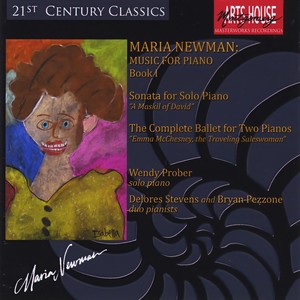
Maria Newman: Music for Piano, Book I
- 流派:Classical 古典
- 语种:英语
- 发行时间:2009-01-29
- 类型:录音室专辑
- 歌曲
- 时长
-
Sonata for Solo Piano, Maskil in A Major, Op. 32, No. 6
-
The Complete Ballet Music from "Emma McChesney" for 2 Pianos in E Flat Major, Op. 39, No. 1
简介
Sonata for Solo Piano (“A Maskil of David”) Maria Newman's "Maskil" is based on the biblical King David's title for Psalm 55, wherein he finds comfort from the wickedness and treachery of his enemies in God's protection. The Hebrew term, "Maskil," is a word of undetermined definition; it has been used both in reference to a musical instrument, and has been used as a term meaning "understanding." Further, in the 19th century, a group of secular scholars (as opposed to Biblical, Talmudic and religious scholars) referred to themselves as the "Masklim." Musically speaking, Newman's opening movement (Psalm 55), is based directly on David's biblical psalm. Though this movement relies heavily on text painting, no direct syllabic rhythmic relationships are utilized between the musical lines and the text itself, as might be present in a song. Rather, the opening dirge is representative of oppression; the tremolos, of the dove of freedom. Lyrical sections represent David’s love of and dependence on God, while driving rhythms are warlike. A conflict of emotion and turmoil, the movement eventually resolves with a juxtaposition of the opening A major dirge and the F# pentatonic “dove of freedom” motive. Formally, the movement is in a mirrored arch with the motivic material progressing towards a demented waltz section – the formal apex of the movement – after which the formalized sections reappear in reverse order, thus signifying internalization of David’s ideals. The slow middle movement is a fugue, whose subject appears in different forms including inversion, retrograde, and retrograde inversion. The subject emerges lonely and haunting, incorporating its language from the interval of an augmented fourth (tri-tone). Progressing towards heated and ardent incantations of the fugal subject musical fabric, the intention is for the work to appear through-composed, as though telling a tale. Also unusual is the quiet materialization of an extremely tonal and reposed episodic statement containing none of the movement’s fugal subject properties. The final movement is a “carnival-like” rondo. Incorporating a slower middle section, beseeching in its harp-like arpeggiation, this avid finale is rhythmically and emotionally fervent in its use of huge octave displacments, a musical reflection of its protagonist’s (David’s) impulsive yet volatile, ever-changing personality. “Maskil” was commissioned by the California Association of Professional Music Teachers (CAPMT) of the Music Teacher’s National Association, and it was premiered by eminent pianist, Wendy Prober, on January 28th, 1994 in Pasadena, CA. The Complete Ballet for Two Pianos – Emma McChesney, the Traveling Saleswoman Emma McChesney, a feisty and very successful traveling saleswoman, is a fictitious character created by the prominent author, Edna Ferber, who wrote the Pulitzer Prize-winning “Showboat!” Maria Newman composed the four-act ballet music around Ferber’s character, with each act illustrating a different picture in the life of Emma McChesney. Act One: Plucked inside the piano, the opening chimes reveal a clock ticking away the timed departure of a train. Emma McChesney is to be on that train, off to sell her wares. Following the engine’s whistle, the main musical material startles with the sudden jolt of the rail cars chugging out of the station, and the subsequent hustle and bustle of the train on its course. Newman’s use of seventh chords in repeated eight-note patterns illustrates the movement of the train itself. This motion, often steady, is frequently interrupted by jarring gesticulation. Act Two: While en route, Emma tells her traveling companions of her life, its hardships, heartaches, joys and rewards. Formally, this slow movement is episodic and quixotic, as the music seeks to tell Emma’s story from an emotional stance. Act Three: The recitativo-like opening of The Robbery leads to a tongue-in-cheek and comedic allegretto depicting an ungainly robbery. Here, Emma is quite able to outdo a lumbering assailant and regain her integrity. Act Four: Emma loves to dance. She is also a devoted mother to her son, Jock. In this scene, the musical motives briefly revisit the main material of Act One, as Emma returns from her far-away places of work. Once safely ensconced at home, Emma is thrilled to be with Jock once again. Insisting that Jock learn to love the art of dancing as much as she, Emma maneuvers him into place for a lesson or two. Increasingly, Newman’s music grows eager as the fanatical dance lessons progress, ultimately flaring with a zealous passion to a wild and mirthful conclusion. Maria Newman was commissioned in 1999 by the Delores Wunsch Stevens Foundation to compose a concerto for piano and full orchestral forces. Delores Stevens gave the fiery premiere performance with Newman conducting, and the concerto received many subsequent performances in this form. Newman and Stevens won a rare 2001 “Debut Award” from the Young Musician’s Foundation for their efforts. The two-piano orchestration was transcribed by the composer in 2002 as a work for chamber ballet. American composer, Maria Newman, is the daughter of 9-time Oscar winning film composer and celebrated Hollywood Bowl Orchestra conductor, Alfred Newman, and she has become a much-noted composer of concert music, music for the ballet, and silent film. Ms. Newman’s compositions have been nominated for the Pulitzer Prize and the Grawemeyer Award on numerous accounts, and the composer has received honors from the US Congress, the California State Senate and Assembly, and the National Endowment for the Arts. Her original music library consists of over 150 works.


